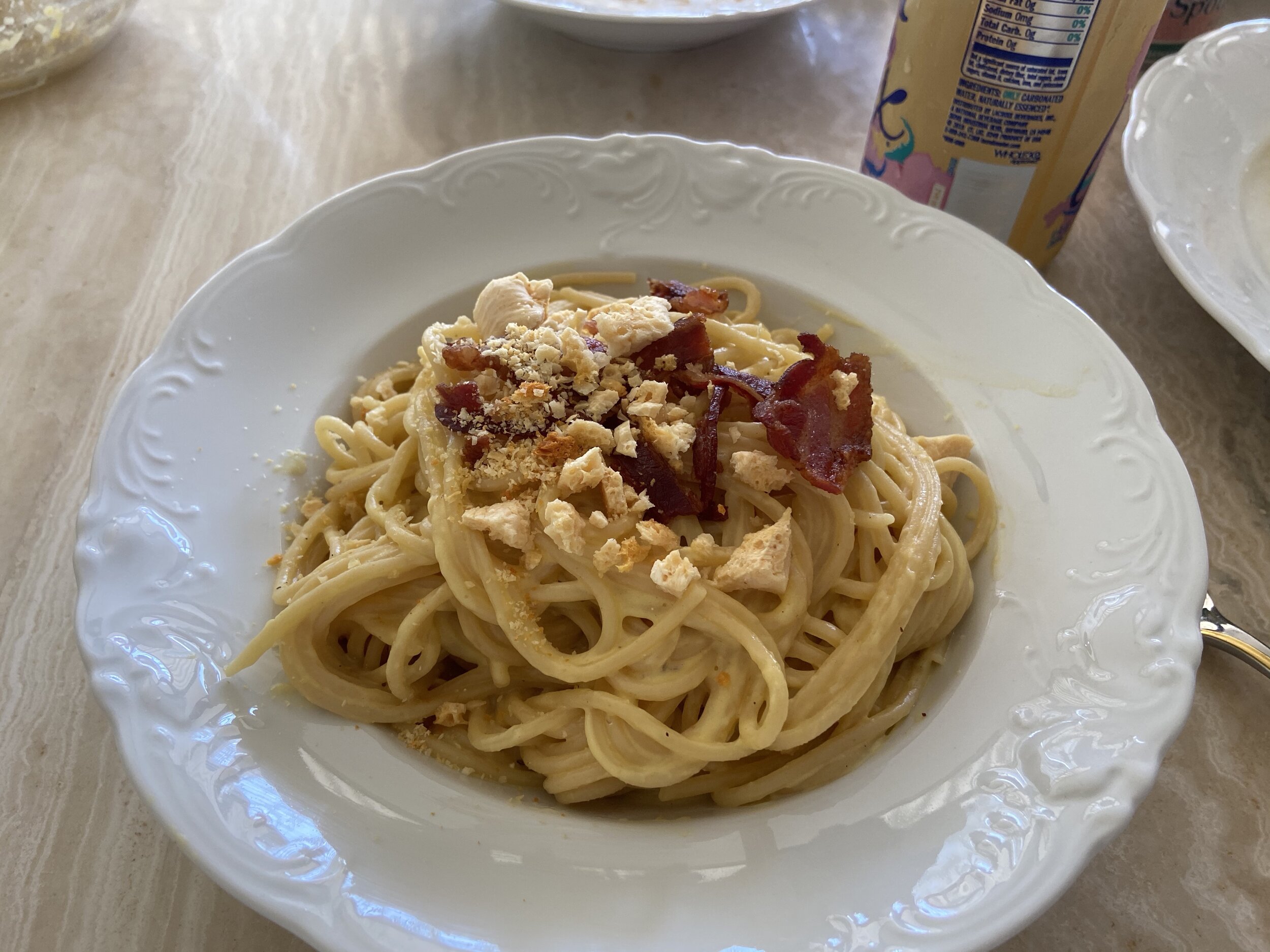Before resuming our Tour of Italy (sorry chain Italian restaurant named for a place where oil-bearing berries grow), I'd just like to say that I've missed everyone here. I've been playing the actual work game, and so it isn't always easy to maintain a humble, high quality, world-renowned food blog. In any event, I hope to make up for lost time this holiday season. I've been cooking up a storm these past months, and I hope you have, too! Anyway, care to recommence our journey?
Again, we embark upon our quest for creamy, white sauces that aren't hideous. So we will turn to Carbonara. In the US, we don't see it very often, relative to Alfredo. In the UK, you probably only ever see Carbonara, and it occupies the same dubious place that Alfredo does in the US. Essentially, wherever it appears, Carbonara is treated as Alfredo + cured pork product, be it bacon or ham. If you thought bad Alfredo was bad, you're in for a special horror: Carbonara can be a horrible off-white blob studded with fatty, oily chunks of salty, chewy pork and coagulated bits of scrambled egg. Please don't be sick. There's work to do.
Unfortunately, the pasta-industrial complex has created this evil twin, while the other sits in oblivion in an Iron Mask. The real Carbonara it isn't a cream sauce at all. In fact, it isn't a sauce that you can really prepare independently of pasta, as we'll see below. Most interpretations emphasize indulgence and extravagance, which, to be fair, is based in reality: it's hard to have a bacon/egg dish that isn't luscious. But excess for excess' sake is not and never has been the main thrust of this dish:
Conceptually, the dish, like Alfredo, has been around for a very long time, before being officially named. Like Alfredo, the name seems to have arisen in Rome around World War II, as American GIs went around, trying to use their broken Italian to ask Roman restauranteurs if they would make their new favorite dishes. The name "Carbonara" refers to mining and coal ("carbon"), but there are two stories as to the origins of the name. The first refers to the myth that it was simple fare, so simple that coal miners could make it on their little stoves before returning to the mine. The other comes from the fact that the dish asks for a heavy dusting of black pepper before serving, which happens to look like a blanket of soot. In any event, the dish has historically humble origins, based in the veneration of local goods--cured pork, egg, cheese--and coping with wartime rationing during WWII. The magic of the dish, then, is not loading up on fat and calories for their own sake, but on feeling like a monarch while using the ingredients of a mere laborer.
This is all to say that Carbonara is terribly misunderstood. As lovers of Italian food, it's now up to us to try to give it a serious makeover, to cut the fat, both conceptually and literally, and let simple, easy luxury carry the day.
Spaghetti Carbonara
One pound spaghetti (or bucatini)
1/2 to 3/4 pound of bacon
6 egg yolks
One garlic glove, minced
Too much parmesan cheese, or a parmesan/romano mix (at least 1.5 cups)
Black pepper to taste.
Put your pasta on to boil, but use about three-quarters of the water you would usually use--you'll see why in a couple of paragraphs. You can use spaghetti, or, as this is a Roman dish, you can try bucatini, kind of like a drinking straw with a very tiny hole.
As your pasta works, time is now of the essence. Put your bacon in the pan, with a light drizzle of oil. Using a small amount of oil in the pan will allow the bacon fat to render more readily, as it will have something to dissolve into. A note on your pork: in Rome, they use guanciale (gwan-CHIALE), which is cured pork jowl. Unless you live on a pig farm, or live next to a really impressive import store, you'll have a hard time with guanciale. You could use pancetta, but there's something about the smokiness of American bacon that's especially appealing. And, you might already have it in your refrigerator. As your bacon gets nice and crispy, drop your garlic clove into the fat and let it bubble gently. But DON'T BURN IT. Just infuse the bacon fat with the essential oils in the garlic.
In a bowl on the side, crack your eggs. To separate the yolks, just crack an egg in your hand and let the white run through into a separate vessel, then plop the yolk into your main bowl. Add the cheese. You'll want a lot of cheese. Parmesan is very good, because it is subtle and nutty. But, as this is a Roman dish, it is often made with Romano. Romano is pretty pungent, so I wouldn't use only Romano, but a nice blend will check all the cheesiness boxes, and will stand up to the smokey bacon. Cover all of that with pepper.
Beat that all up really well and transform it into an effective proto-sauce. By this point, your bacon should be about done. Pull it out of the fat, and let it drain on the side and get crispy. Turn the heat off the pan, and let it all cool a little. The pasta is almost done, so now's the time for explanation. What we want to do is create a sauce from the raw eggs, cheese, and hot pasta. But we want a smooth sauce and not scrambled eggs. How do we do it? SCIENCE!
**Start SCIENCE alert** This cloudy broth is pasta water. Remember when I suggested you use about 3/4 as much water as you usually do? Now you have water that has a higher concentration of starch. This is great. What we're going to do is use two scientific resources at our disposal. The first, is called tempering. Eggs are splendid little capsules of protein and fat. This means their culinary potential is endless. But not without danger. Proteins denature. This means that when they get shocked with heat or acid, they lose their normal shape and get hard. In some instances, this is what we want, i.e. scrambled eggs. Not here. In order to prevent denaturation, we will slowly raise the heat on the eggs, by adding hot pasta water to them and stirring. Then we'll have custard and not clumps.
The other resource is, as you may have guessed, is emulsification. As discussed several times before, emulsification is the process by which aqueous and fatty layers hang together, like in creamy salad dressings. Eggs are magical because their yolks contain amazing emulsifiers, which is why they so often appear in things like mayonnaise and Caesar salad. That's why we have two extra yolks. And the excessively starchy water will aid the yolks by making everything thicker. **End of SCIENCE alert**
tl;dr: egg yolks are special, and we want to slowly add hot pasta water to them to prevent them from scrambling.
Okay. Pasta's done. It's showtime. Drain the pasta, and reserve about a full mug of hot pasta water. Be careful, okay?
Dump the spaghetti into the warm pan of bacon fat and stir to coat. Add a couple shards of bacon right now.
Now the magic happens. Slowly whisk about a third of the hot water into the egg blend, until you see the cheese just start to melt. Now dump the mix back into your pasta, mix like hell, and pray for something like this:
See that creamy, shiny coating? Just yolky silkiness coating every one of those noodles. Turn it all up and douse the top with even more cheese and pepper.
Here’s a fun tidbit. If you have a nice block of parm or romano left, cut off a couple of chunks. Put them in the microwave for 30 seconds. Wait a few seconds. Then another 30 seconds. As the water in the cheese boils, the melty cheese will trap the gas in a network of little bubbles. As everything solidifies, you’ll have a hard, crispy sort of honeycomb network. Chop them up, sprinkle them over the top, and up your game with a nutty, toasty crunch.
Alright, that about does it. As you can see, no cream necessary. No goo and no soy lecithin or xanthan gum or other creepy stabilizers. We can dump that old fraud and instead, smuggle it out of that Iron Mask and start a Revolution! Well, perhaps I'm being a *tad* dramatic. But only a tad.
Good food is really special, I think. Particularly around this time of year, working over a steaming pot of goodness can facilitate the blooming of all of the wonderful things that make humanity awesome. I mean, that's what Carbonara, and Italian food more generally, is all about: seeing the joys one can derive from just a few basic inputs. Grab a loved one, give them a squeeze, and make something great together.








